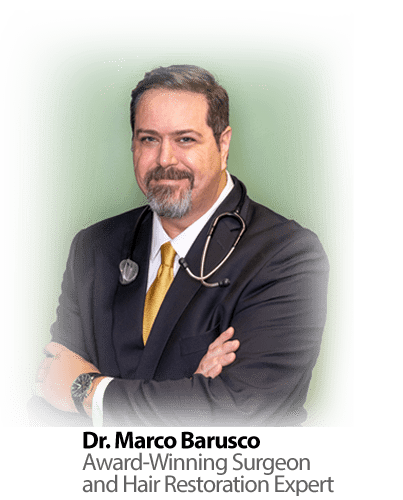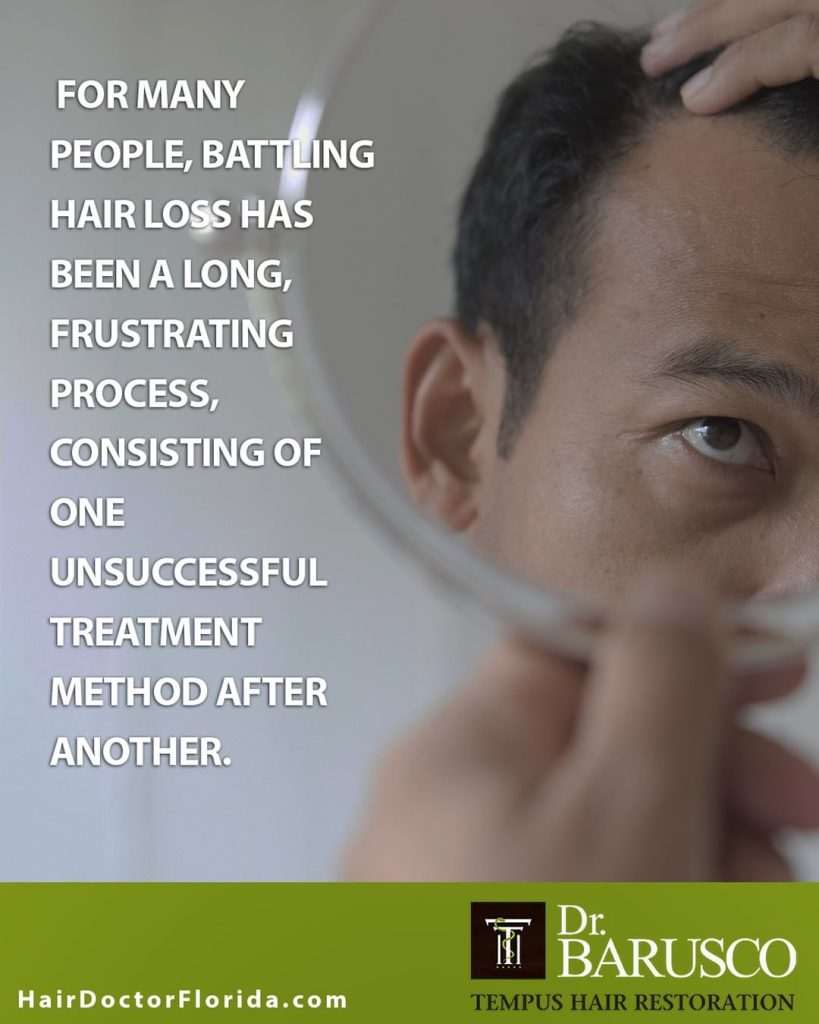We at Tempus Hair Restoration often talk about the hair restoration journey. This is an accurate analogy, as there are many steps from the time you decide to explore your hair restoration options to the happy day when your new growth fills in so that you once again recognize the man in the mirror. However, there is much to learn to navigate this journey successfully and achieve the result you want.
We always sign off our Tempus Hair Restoration monthly blog post with the statement, “Choose your surgeon wisely.” Of course, we mean Dr. Marco Barusco – Founder and Chief Medical Officer at Tempus Hair Restoration. This month, we dedicate our blog post to introducing you to Dr. Barusco and the many reasons why he is the wise choice for your hair restoration procedure!
Meet Dr. Marco Barusco
A native of Brazil, Dr. Barusco decided to pursue advanced training in hair restoration techniques after completing his training in general surgery. His family’s history of hair loss weighed heavily in Dr. Barusco’s choice of specialty, knowing that he was very likely to experience it as well.
Says Dr. Barusco, “I’m a hair transplant patient too, so I understand how hair loss can affect your confidence and why I’ve dedicated my professional life to helping others who suffer from hair loss.”
In practice since 1998, Dr. Barusco is a leading hair restoration surgeon, devoted to developing and bringing the most advanced techniques to his patients. Moreover, he is a tireless educator who lectures and conducts workshops both nationally and internationally to instruct current hair transplant surgeons and educate the next generation. He is Assistant Professor of Surgery at the University of Central Florida College of Medicine, and has written chapters for numerous hair restoration textbooks.
Dr. Barusco also has been honored to serve in key positions for hair restoration organizations, including the following:
- Past President and Diplomate – American Board of Hair Restoration Surgery (ABHRS)
- Member of the Board of Directors – ABHRS
- Diplomate – Education Commission for Foreign Medical Graduates (ECFMG)
- Member of the Board of Directors – Cosmetic Surgery Foundation (CSF)
- Fellow – International Society of Hair Restoration Surgery (ISHRS)
Know Your Surgeon – Who Will be Performing Your Hair Transplant Procedure?
Now that you know Dr. Barusco’s background, think about other surgeons or hair transplant clinics you might be contacting for a consultation. Who will be performing your surgery? What is his or her professional background? If you schedule a consultation at a franchise clinic, you may not be meeting the surgeon, but a salesperson or medical technician. At some clinics, unlicensed technicians illegally operating robotic devices harvest and implant hair follicles. We invite you to read Dr. Barusco’s article about the significant risks of this too-common practice.
In our blog post – “Behind the Reviews – Dr. Marco Barusco’s Hair Transplant Patients Share Their Stories” – beard transplant patient Argelis F. describes his consultation experience with Dr. Barusco as an example of how this important discussion should be conducted.
“I called plenty of other surgeons, but his was the only practice I called where I spoke to the doctor himself. With the other places, I never got the actual procedure explained to me by the doctor. It was always by somebody else in the office. But Dr. Barusco was different.”
So what should this conversation be like? Dr. Barusco’s consultations cover the following areas: your hair loss history, your family history of hair loss, your medical history, your past and current medications, your allergy history, surgical history and a timeline of your hair loss. The consultation will also include an examination of your hair and a basic medical examination if the consultation is conducted in-office. Dr. Barusco will then arrive at a diagnosis of your hair loss.
Although not generally known, people can have more than one type of hair loss. For this reason, Dr. Barusco may have two or three ideas of the cause – which is known as a differential diagnosis.
Once the diagnosis is given, Dr. Barusco will discuss your hair restoration goals with you. Dr. Barusco knows that good communication is essential to getting the result you want – which includes setting realistic expectations of what you can expect. For example, a 45-year-old can’t get back the hair he had at age 18, but can get a good hairline and aesthetically pleasing crown coverage, if those are the goals. It’s a collaborative process in which you and Dr. Barusco have a candid discussion about what’s possible, and the best procedure for achieving the optimum outcome.
Dr. Barusco’s Leading-edge Hair Transplant Procedures
Dr. Barusco has long been at the forefront of advanced hair restoration procedures, having developed such techniques as the groundbreaking no-shave FUE. Short for follicular unit excision, the no-shave FUE completely conceals harvested donor sites immediately, allowing you to resume your regular activities with virtually no evidence of the procedure.
Going one step beyond this procedure is the long-hair FUE. It is also known as the “preview” long-hair FUE because it provides a preview of what the ultimate result will be. As with any hair transplant, the hair in the newly implanted grafts soon falls out, to be replaced by new growth as the grafts establish themselves. Dr. Barusco is one of only a few doctors in the world with the experience and skill to perform this technique.
Another leading-edge procedure is the combined FUE and FUT (follicular unit transplantation). This technique covers large areas of baldness in a single surgery. Patients with advanced hair loss are typically required to undergo multiple hair transplant procedures to obtain coverage of their entire bald scalp – having to wait one year or more between procedures. This allows patients to achieve their ultimate goal sooner, with one procedure instead of many.
Regardless which procedure Dr. Barusco performs, he harvests and implants each hair follicle by hand. This is essential in selecting the right follicles from the donor area of the scalp, and creating the implantation site to achieve the best possible coverage. Implanting each follicle by hand also allows Dr. Barusco to position them at the correct angle – which is necessary to achieve the look of natural growth. No matter what you may have read or heard, no robotic device can achieve this degree of accuracy or level of artistry.
Dr. Barusco’s Skill in Performing Hair Transplants for Patients with Special Circumstances
Dr. Barusco is also renowned for his skill in performing hair transplants to conceal scars caused by head trauma or surgery (such as facelifts) – as well as restoration procedures for those who have undergone chemotherapy and/or radiation therapy. We invite you to read the inspiring story of “K.J.” – a patient whose near-fatal motorcycle accident left him with a wide scar where surgeons had to replace a section of his skull.
“(The patient’s) case was difficult, and posed a higher risk of serious complications due to the surgeries he had for his head trauma,” said Dr. Barusco. “Particularly the reconstruction of his skull with a synthetic material, which was placed under the area to be transplanted. This made the procedure of transplanting hair more challenging and risky. Most other doctors don’t have the experience or the facilities to perform this procedure under sterile conditions, and with the pre- and post-operative preparations that were needed to do it safely.”
Dr. Barusco created a pre- and post-operative protocol designed to increase safety in these types of procedures. This protocol was published in a scientific journal and in a medical textbook, and today is used by many doctors in the field.
As for K.J., his hair transplant successfully concealed his scar, allowing him to put this painful reminder of his traumatic injury in the past – and is now making the most of his second chance at life.
Success by Design – How Dr. Barusco’s Aesthetic Sense Creates Outstanding Results
Do you remember paint-by-numbers pictures? They’re still around and still the same: an outline of a drawing printed on canvas that has numbered sections for the different colors of paint to be used. The finished product is technically a painting, yet far from a work of art. Consequently, a hair transplant by a surgeon who lacks a sense of aesthetics may cover bald spots, but will look somewhat “off.”
As our blog post – “Principles of Male Hairline Design” – covers, in addition to properly positioning the hairline restoration to your facial features, implanting each follicular unit to create the appearance of natural growth is essential to preventing the result from looking like a hairpiece.
“There are no straight lines on the human body,” says Dr. Barusco. “You don’t want to put anything in a straight line because it doesn’t look natural. It will catch peoples’ eyes for the wrong reason. You want to create variability.”
During the transplant procedure, Dr. Barusco implants hair grafts to build macro and micro irregularities into the hairline. Each follicular unit graft can contain one to three (or even four) hair follicles, which Dr. Barusco varies to further create a natural effect.
Dr. Barusco also takes great care in creating a frontal temporal transition to achieve this visual variability. “If I just design a hairline and go straight into the hair without creating that soft transition to the temples, it’s going to look artificial. The effect will be so obvious that people will either know you’ve had a transplant, or think you’re wearing a hairpiece. Neither is a desirable outcome.”
Dr. Barusco Puts the Patient First
If you’re considering a hair transplant, you probably don’t know what to expect regarding the patient experience. What you should know is that you shouldn’t be treated like a product on an assembly line.
Dr. Barusco always puts the patient first. He makes sure that you understand how local anesthesia will be administered before the procedure, and that you have the appropriate pain management medications immediately after. His patients typically report that they are comfortable and relaxed during the procedure itself. They often are pleasantly surprised that Dr. Barusco gives them his personal cell phone number if they have questions, and calls them later that evening post-op to follow up on how they’re doing.
To further ensure a smooth recovery process and success of the procedure, post-op examinations are later scheduled at various intervals to allow Dr. Barusco to monitor scalp health and hair growth.
Choose Your Surgeon Wisely – Choose Excellence with Dr. Barusco
When it comes to hair restoration, expertise and compassion are essential. Dr. Barusco’s commitment to excellence, patient-centered approach and artistic precision make him a top choice for those seeking to restore their confidence and reclaim their youthful appearance. Explore your hair restoration options with Dr. Barusco, and embark on a transformative journey toward a revitalized you!
Ultimately, choose your surgeon based on experience, results and integrity. Dr. Barusco’s long list of accomplishments, his notable artistic ability and his successful surgical team make Tempus Hair Restoration a renowned practice. We understand that the main concern you may have is cost, which is why we offer financing options that can place this important goal within reach.
Contact us to schedule your free virtual consultation. Dr. Barusco conducts every consultation himself, giving you the opportunity to learn your options in the comfort of your home – or any location, on any internet-enabled device.
Dr. Barusco conducts consultations in English, Spanish and Portuguese. For your greater convenience, Tempus Hair Restoration offers a two-night complimentary hotel stay to out-of-town clients who travel 100 miles or more to our Port Orange, Florida, surgical center. No matter how far the distance, we welcome the opportunity to help you on your hair restoration journey!



 “I know many clients who have seen major improvements by Dr. Barusco’s hands. However, the two that stand out to me are the following.
“I know many clients who have seen major improvements by Dr. Barusco’s hands. However, the two that stand out to me are the following.